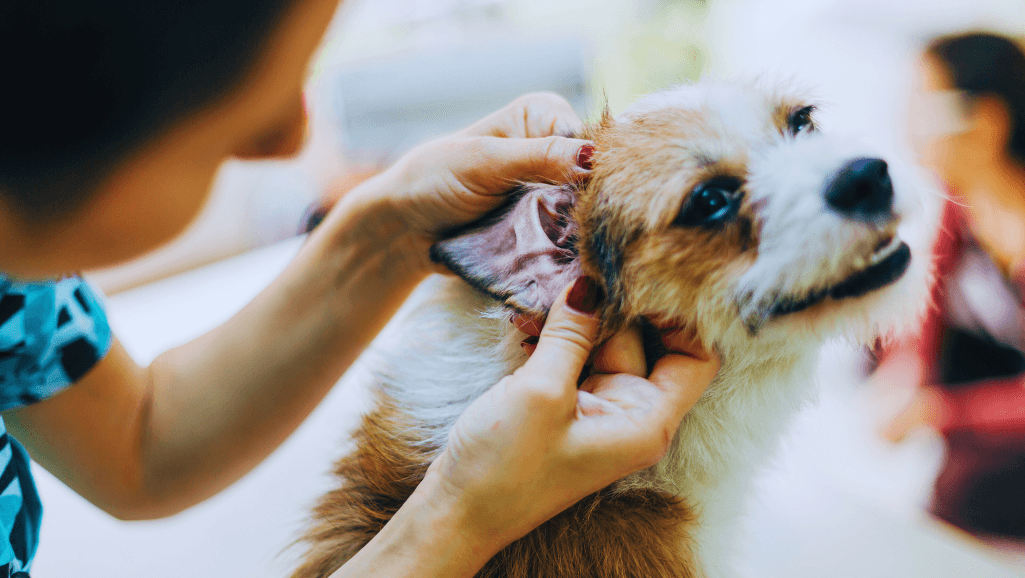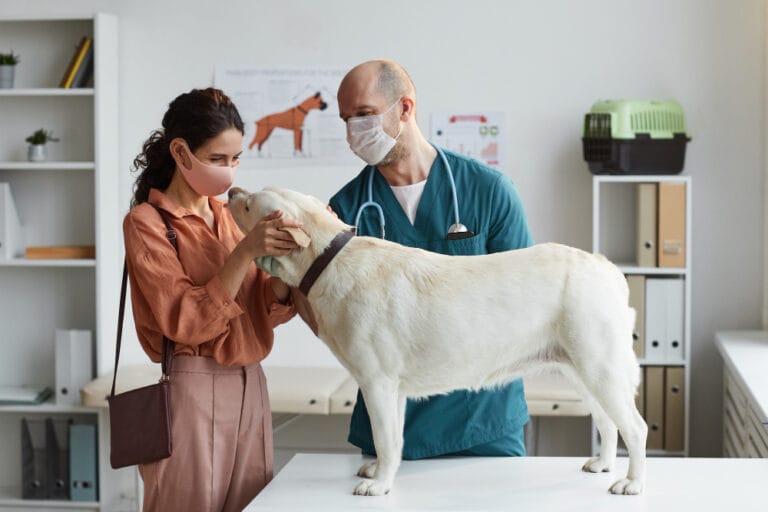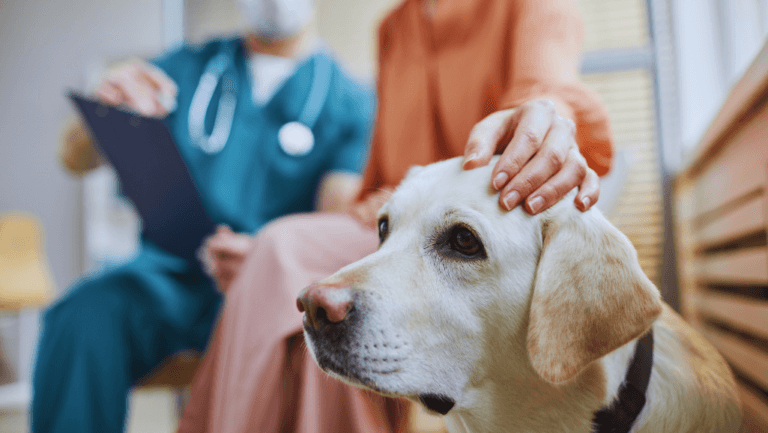Dental disease is one of the most common medical conditions found in dogs, and periodontal disease is the most common dental disease in dogs. It is highly preventable and can have serious health implications if left untreated. In this section, we will explore what periodontal disease is, the symptoms, causes, diagnosis, treatment, prevention, and the potential outcomes if left untreated.
Key Takeaways:
- Dog dental diseases
- Periodontal disease is the most common dental issue in dogs.
- It is caused by the accumulation of dental plaque and tartar on the teeth.
- If left untreated, it can result in gum infections, bone loss, and tooth loss.
- Symptoms include bad breath, difficulty chewing, bleeding gums, and pawing at the mouth.
- Treatment involves professional dental cleanings, scaling and polishing, and in severe cases, extractions
- Prevention includes regular dental care, such as brushing your dog’s teeth, and regular vet check-ups
- Untreated periodontal disease can lead to eye issues, organ damage, jaw fractures, oral cancer, and tooth abscesses.
What is Periodontal Disease in Dogs?
Periodontal disease, also known as periodontitis, is a common dental issue in dogs that affects their teeth, gums, and surrounding structures. It is primarily caused by the accumulation of dental plaque and tartar on the teeth, leading to inflammation and subsequent damage.
This condition is characterized by the following key factors:
- Dental Plaque: The formation of a sticky film on the teeth, consisting of bacteria, food particles, and saliva.
- Tartar Buildup: Over time, dental plaque hardens and turns into tartar, also known as dental calculus.
- Gum Infections: The presence of tartar irritates the gums, causing inflammation and leading to infections.
- Bone Loss: Continual gum infections can result in the destruction of the supportive bone structure around the teeth.
- Tooth Loss: In severe cases, as the bone loss progresses, the affected teeth may become loose and ultimately fall out.
Dogs of all breeds can develop periodontal disease, but smaller breeds are particularly susceptible due to their dental anatomy. The buildup of plaque and tartar on their teeth is often more prominent, making them more prone to inflammation and subsequent dental problems.
To visualize the impact of periodontal disease on dogs, refer to the following table:
| Dental Issue | Consequences |
|---|---|
| Gum Infections | Pain, redness, swelling, and bleeding of the gums |
| Bone Loss | Weakening of the bone structure supporting the teeth |
| Tooth Loss | Loose or missing teeth, difficulty eating and chewing |
Symptoms and Diagnosis of Periodontal Disease in Dogs
Periodontal disease in dogs can manifest through various symptoms that pet owners should be aware of. Recognizing these signs can help diagnose the condition early and ensure prompt treatment. Some common symptoms of periodontal disease in dogs include:
- Halitosis: Bad breath is a common indication of dental problems in dogs.
- Difficulty Chewing: Dogs with periodontal disease may experience pain or discomfort while eating or chewing.
- Bleeding Gums: Inflamed or infected gums can result in bleeding.
- Pawing at the Mouth: Dogs may paw at their mouth to alleviate discomfort caused by dental issues.
- Behavioral Changes: Periodontal disease can lead to changes in behavior, such as decreased appetite, irritability, or withdrawal.
It is important to note that some dogs may not show obvious symptoms of periodontal disease, especially in the early stages. This is why regular dental check-ups are crucial for early detection and treatment.
Diagnosis of Periodontal Disease in Dogs
Diagnosing periodontal disease in dogs involves a comprehensive examination by a veterinarian. The dental exam includes a visual inspection of the teeth and gums, as well as the use of diagnostic tools to assess the severity of the condition.
Dental x-rays play a significant role in the diagnosis of periodontal disease. They allow veterinarians to evaluate the extent of dental plaque, tartar buildup, and potential bone loss beneath the gumline. These images provide valuable insights into the overall oral health of the dog and help determine appropriate treatment approaches.
In addition to x-rays, measurements of bone loss may be taken using specialized tools. This helps gauge the amount of bone that has been affected by periodontal disease and enables a more accurate assessment of the condition.
By combining visual examinations, dental x-rays, and bone loss measurements, veterinarians can provide a comprehensive diagnosis of periodontal disease in dogs and create an individualized treatment plan.
| Diagnosis Methods | Advantages | Limitations |
|---|---|---|
| Dental X-rays |
|
|
| Bone Loss Measurement |
|
|
Treatment and Management of Periodontal Disease in Dogs
When it comes to treating periodontal disease in dogs, the appropriate course of action depends on the severity of the disease. Mild cases can often be managed with a professional dental cleaning that includes scaling and polishing, while more advanced cases may require extractions or other dental procedures. Managing periodontal disease in dogs also involves a proactive approach to home dental care and regular veterinary check-ups.
In mild cases of periodontal disease, a dental cleaning performed by a veterinarian is often the first step in treatment. This procedure involves removing dental plaque and tartar from your dog’s teeth. Scaling and polishing are essential components of the cleaning process, as they help to remove plaque and smooth the tooth surface, making it more difficult for bacteria to accumulate.
For more advanced cases of periodontal disease, extractions may be necessary. This involves removing teeth that are severely affected by disease or have become loose due to bone loss. Although losing teeth can be concerning, it is necessary to prevent further complications and improve your dog’s overall oral health.
Home dental care is essential for managing periodontal disease in dogs and preventing its progression. Regular brushing of your dog’s teeth is the gold standard in home dental care. Using a dog-specific toothbrush and toothpaste, gently brush your dog’s teeth a few times a week to remove plaque and bacteria. There are also dental care products available, such as dental chews or water additives, that can help to complement your dog’s oral hygiene routine.
Regular check-ups with a veterinarian are crucial for the management of periodontal disease in dogs. During these check-ups, your veterinarian can evaluate the progression of the disease, perform dental cleanings as needed, and provide guidance on home dental care. These routine visits also allow for early detection of any potential issues or complications, ensuring prompt intervention and prevention of further dental problems.
Benefits of Regular Vet Check-ups for Periodontal Disease Management
- Prompt treatment and management of periodontal disease
- Early detection of any complications or issues
- Ability to address any underlying dental health concerns
- Professional assessment and cleaning of your dog’s teeth
- Guidance on maintaining proper home dental care
By staying proactive in the treatment and management of periodontal disease in dogs, you can help improve your furry friend’s oral health and overall well-being. Remember to prioritize regular home dental care, including brushing their teeth, and schedule regular check-ups with a veterinarian for professional dental cleanings. Together, you can ensure that your dog maintains a healthy and happy smile for years to come.
Prevention and Potential Outcomes of Untreated Periodontal Disease in Dogs
Preventing periodontal disease in dogs is crucial for their overall health and well-being. By maintaining good dental hygiene and implementing regular brushing, you can significantly reduce the risk of dental issues in your furry friend. Establishing a dental care routine early on can help prevent the onset of periodontal disease and avoid potential complications.
Dental hygiene plays a vital role in preventing periodontal disease in dogs. Regular brushing with a pet-friendly toothbrush and toothpaste helps remove plaque and tartar buildup, preventing the development of gum infections and reducing the risk of bone loss and tooth loss. Introducing dental care products such as dental chews and treats that are specifically designed to promote dental health can also support preventive efforts.
Without proper treatment, periodontal disease in dogs can lead to various serious health issues. Some potential outcomes of untreated periodontal disease include:
- Eye issues: The bacteria associated with periodontal disease can spread to the eyes, causing infections, inflammation, and potential damage to the vision.
- Organ damage: The bacteria from the infected gums can enter the bloodstream and spread to other organs, leading to systemic infections and damage to vital organs such as the heart, liver, and kidneys.
- Jaw fractures: Severe bone loss resulting from advanced periodontal disease can weaken the jawbone, increasing the risk of fractures and mobility issues.
- Oral cancer: Chronic inflammation from untreated periodontal disease can contribute to the development of oral cancer in dogs.
- Tooth abscesses: Untreated periodontal disease can lead to tooth abscesses, which are painful infections that require immediate veterinary attention.
Early detection and timely treatment are key to preventing these potential outcomes. Regular dental check-ups with a veterinarian and professional dental cleanings can help identify and address any signs of periodontal disease before it progresses. If you notice any symptoms such as bad breath, difficulty chewing, or bleeding gums, it’s important to seek veterinary care promptly to prevent further complications.
Investing in preventive measures and proactive dental care for your dog can significantly improve their quality of life and ensure their oral health remains optimal. By taking the necessary steps to prevent periodontal disease, you can help your furry companion avoid potentially serious health issues and enjoy a happy, healthy life.
Conclusion
Dog dental care is crucial for the maintenance of your pet’s oral health and overall well-being. Periodontal disease is a common issue in dogs, but with proper dental hygiene and regular visits to the veterinarian, it can be prevented and effectively managed.
By taking a proactive approach to your dog’s dental care, you can help prevent dental diseases and ensure a happier and healthier pet. Regularly brushing their teeth, providing dental chews and toys, and scheduling routine dental cleanings with your veterinarian are all important steps to maintain their oral health.
Remember that prevention is key when it comes to canine oral health. Good dental hygiene practices and regular check-ups can go a long way in keeping your furry friend’s teeth clean and their gums healthy. Investing in your dog’s dental care now can help prevent potentially serious health issues down the line.




















